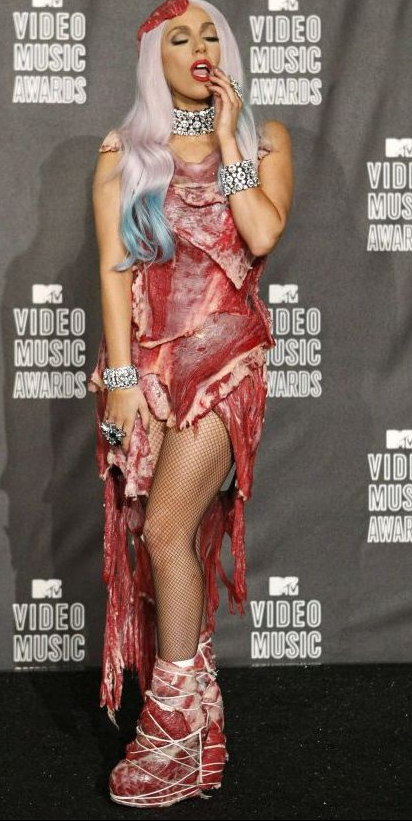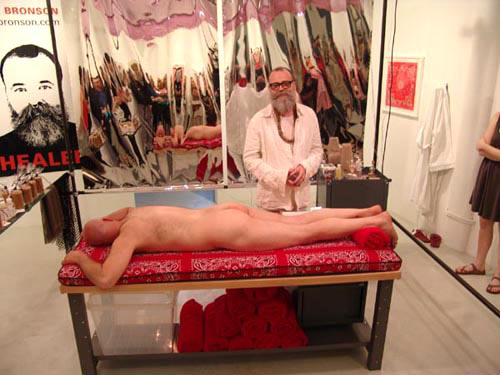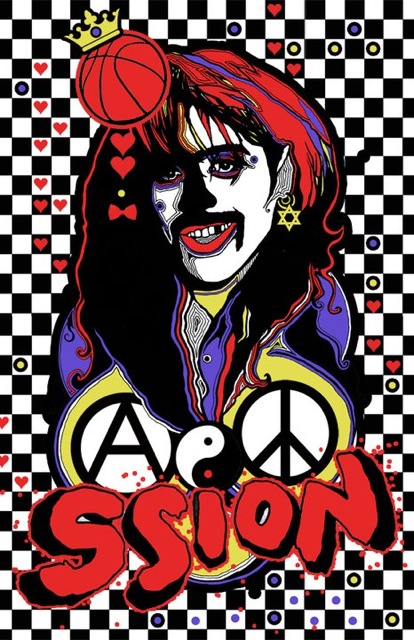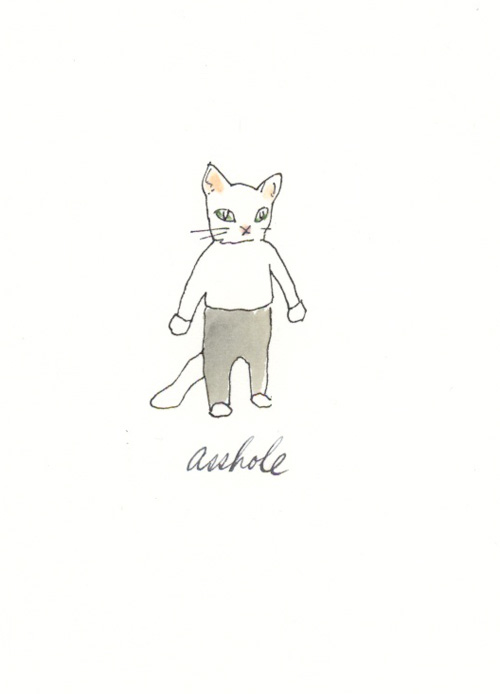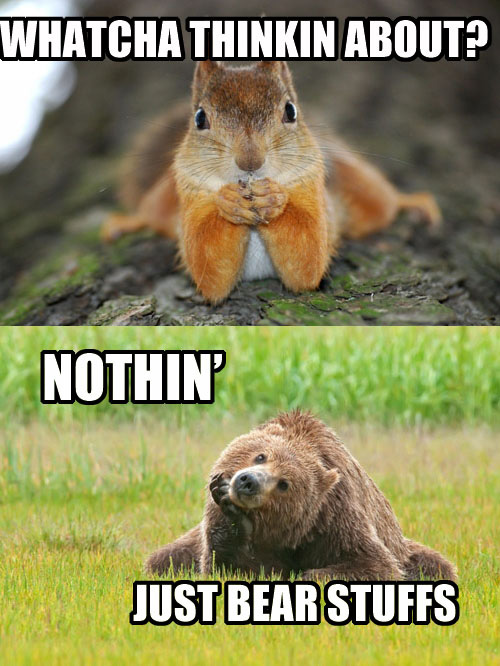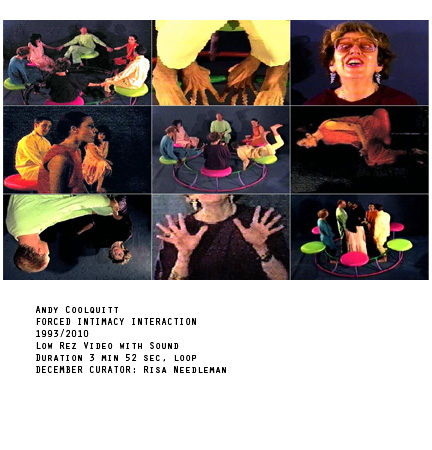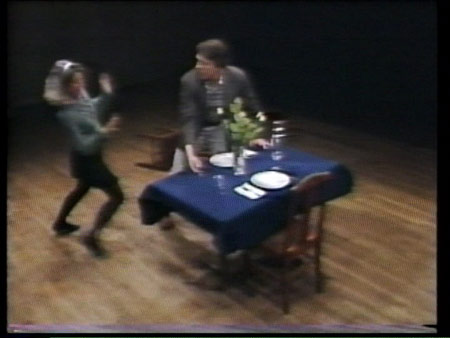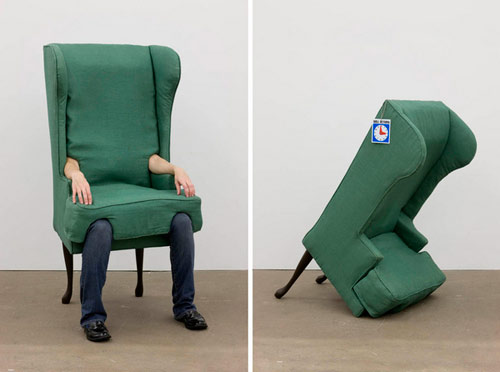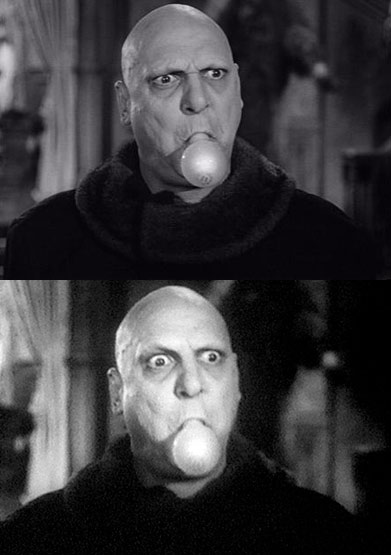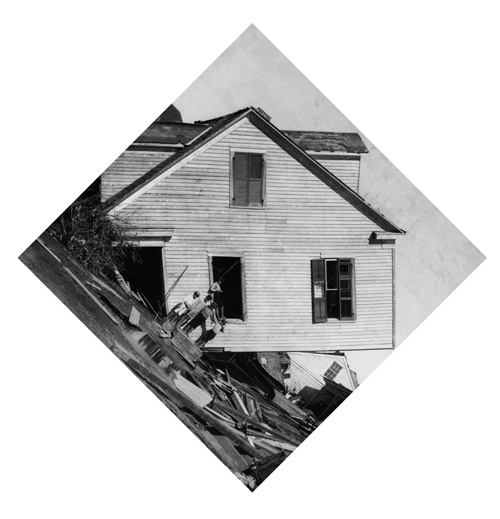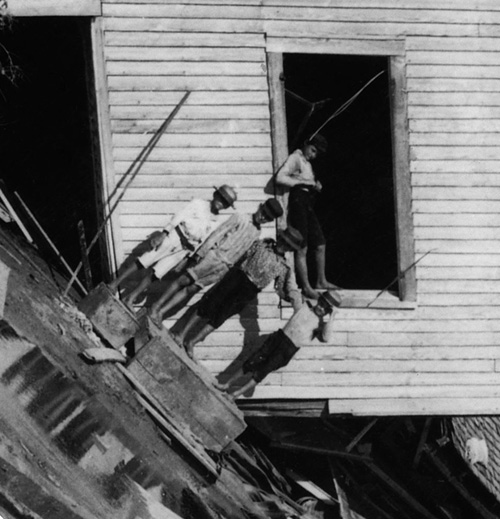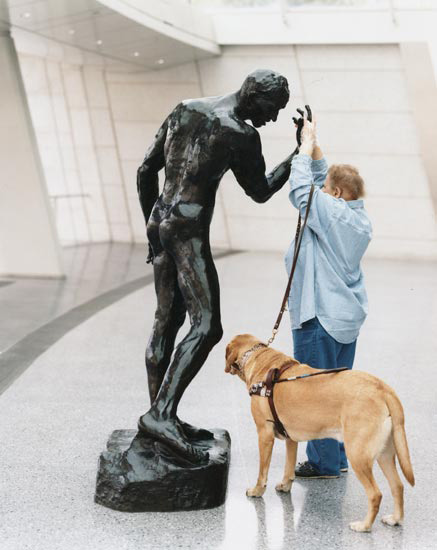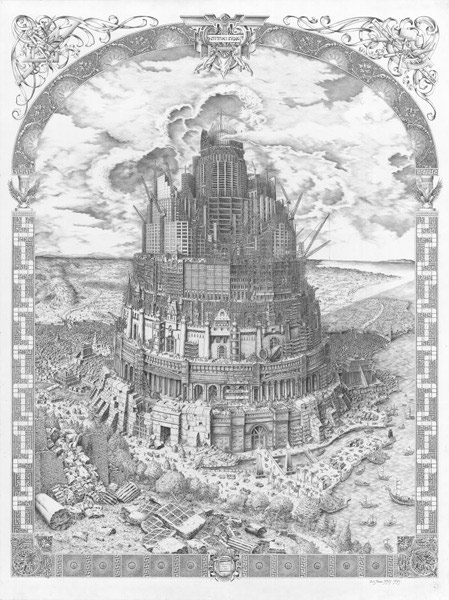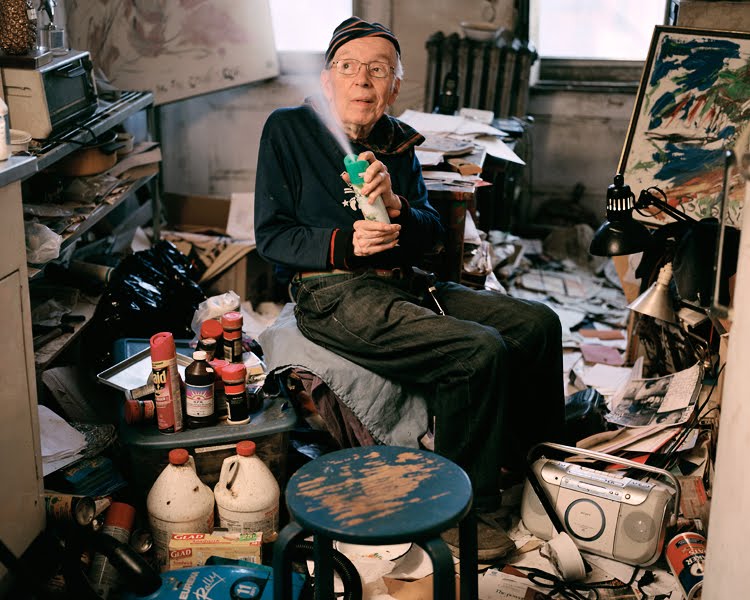Archive for the ‘Uncategorized’ Category
Meat Markets
December 18th, 2011
The Artist of the Month for June 2011 is Alisa Baremboym.
Artist Richard Phillips selected Alisa. Her print, Cured, is printed with archival ink on silk, with hand-sewn edges. Here, we discuss her print, her imagery, and her “process.”
MB: Can you describe the relationship your work has to food? Is it diaristic, like a periodic index of what you eat? Is it about what other people eat? Or do you hope it provokes a viewer’s visceral response?
AB: In using food, I work around the idea of the preserved body. We preserve animal bodies as food in order to extend their life as a biological energy for our own bodies, thus further preserving ourselves. This continuous process loop, like an endless sausage link, relates to our own co-dependent relationship of need and desire.
MB: Regarding your 2009 work, Chuchela, ArtReview wrote, “Baremboym pins a group of cultural references together, flattening them into a shallow pile so that cultural relativity is extruded and we are subtly muscled into considering our own specific relationship to these signifiers around which she plots her narrative points.” Could that interpretation apply to Cured? It embodies and invokes cultural references, and the flattened, shallow pile seems unmistakeable. And making processed meats involves both “extruding” and “muscle.”
AB: Our visible bodies are the external packaging of our layered interiors. Silk can act like a second skin in the same way that ‘natural casing’ envelops the processed meat. In “Cured,” the repeated pattern is meant to extend beyond the fabric’s borders, but ends by the force of the object’s edge. It attempts to be infinite but becomes finite, much like preservation. Culture in this case is not only relative, but a relative byproduct of the need to survive.
MB: Yet, the edge is a catalyst. The edge converts this from a repeated pattern to an object – and an object of a special class. Beyond dimensions and materials, this object has market value, cultural esteem, and archival considerations. It’s indispensable, unlike a food photo in a catalog, menu, or advertisement. Is this implied in the title? To be “cured” implies conversion. Have you cured – converted – this image from the commonplace? Or is it the opposite, and you’ve cured – liberated – it from the rarefied art context?
AB: Framing a limitless pattern is a way to underline the artifice of the image and it’s relationship to the way reality and depictions of reality interact. There is always an element of translation or conversion that exists in my work and also exists in the basic act of making something. Through the lens of photography, I am framing the subject in a way that is always a translation of what it actually is. The photograph is then transferred to a print on silk which is another translation. I am propelled by the idea that images further extend the shelf life of a consumable thing, but ultimately for a finite amount of time. The title “Cured” describes the general act of preserving something so it opens up the conversation beyond just what is depicted in the image.
MB: As cultural objects, these processed meats convey a different priority than a roasted chicken, a pig on a spit, or even a carcass hanging in New York’s Meatpacking District. They also mean something different than a hot dog. And a hot dog seems more American. Does “Cured” have a particular culture in mind?
AB: There are many cultures that use and have used cured meat as part of their cultural histories and traditions. It is more of a symbol of those cultures including my own Russian/American background than a specifically American example of a hot dog, per se. I am interested in the specificity as well as the universality of the sausages depicted because that allows the image multiple meanings and creates part of the tension.
MB: You see the conversion of animal life into biological energy as a process loop. In your view, how is it a process loop more than a food chain, which is more vertical, unilateral, and pyramidal? American meat consumption is an environmental catastrophe, and I wonder how this relates to the infinite/finite conditions you described above, and the need to survive.
AB: The co-dependence is between our own need and desire in relation to sustaining ourselves with things like food and clothing, for example. Our patterns of eating and other biological necessities, make up the pattern of our everyday lives. Repetition gives the illusion of the infinite. The notion of an infinite supply of food is completely false, yet we somehow have that impression based on what we see as consumers in the western world. In this case, culture is a byproduct of our daily lives in the sense that what we develop out of necessity gets refined or processed and becomes culture.
MB: What is the closest you’ve come to wearing a second skin?
AB: We all wear a second skin in the form of clothing, protecting us from the elements on a daily basis. Clothing has a similar relationship to necessity and luxury that food does, which is one of the reasons I choose to combine them.
First Flowers
December 6th, 2011
The Artist of the Month for July 2011 is Paul P.
Curator Simon Watson selected Paul, who produced a pair of archival pigment prints, Untitled, 2003-2011. Here, he discusses the body of work he is building in Florence.
MB: You are in Florence, from what I hear. Can you tell us, first, what took you there and what you’re working on?
PP: I’m in Florence because there is a statue of Bacchus in the Boboli Gardens that I wanted to draw during the wintertime. There is a deep chill here now so the effects are different then when I last made drawings of the statue in the summer. Also there is quite an interesting Ganymede here too, actually several – more than you would think. John Singer Sargent made some dazzling watercolours of Boboli.

MB: How did you decide upon Bacchus over Ganymede? When Zeus kidnapped Ganymede, the most beautiful youth he had seen, he made Ganymede immortal. That immortality seems to live on in so much of your work, which meditates on irresistibly beautiful young men. Do you feel connected with this mythology, especially as a torchbearer? And how do you connect with Bacchus?
PP: I haven’t really chosen Bacchus over Ganymede – I’ve drawn both, many times. In Boboli there is one Ganymede, which is extraordinary. In the sculpture the youth seems to have all of the control over the hapless bird, which yields to his roughhousing. The Bacchus in question (not the obese one astride a tortoise, which is more famous) has perfect, casual contrapposto, locks just longer than shoulder length and a cup dangling out of his hand, obviously empty. It’s situated so it catches the light in a remarkable way. It is as if it, or he, flickers. My broad interest is in transient moments and I think there is something of that here, hewn in stone, and in the atmosphere around it. There are certain statues in different cities that I devote my attention to; a few in Paris, one in Rome, these two in Florence and a few others. Each selected because there is something special about them and where they exist, and then through repeat observation, over time, in different seasons I start to accumulate an almost ‘archival’ kind of knowledge about them. It brings them back to the present.
I don’t feel especially connected to mythology, but I do like their use as analogies. Mortality, rather than immortality would be more my theme and the complexity of a present moment, one which imagines both the future and the past.
MB: Your print, in two parts, embodies two traditions of drawing and painting: the portrait and the still life. Do these images have a personal history to you? Or are they less specific, and more iconic, as representatives of the portrait and still life legacies?
PP: Both of the images for the edition come from a book work which I made and exhibited in 2003. In it, a series of portraits sourced from 1970’s pornographic magazines (the period after gay-liberation and before the AIDS crisis) alternate with floral still lives reprised from the ‘Last Flowers’ of Manet – a series of humble wild-flower bouquets painted on his death-bed in middle-age. They are a testament to the persistence of the aesthetic impulse, and an art-historical precedent for a life cut short.
MB: For me, there’s an air of innocence in those pornography-sourced portraits. But liberation doesn’t beget innocence. Could this aspect of the 1970s, pornography and sexual freedom, be more like a rebirth? If so, then the pairing of the portrait with the still life becomes even more so a pairing of birth and death. As rebirth and early death, the bookends are pushed closer together. Does that interpretation feel close to your ideas?
PP: I don’t know if I see innocence in the portraits. It is more of a collision of emotions and experiences. I like the Elizabeth Bowen quote: “The innocent are so few that two of them seldom meet – when they do meet, their victims lie strewn around”. With regards to birth and death, I see what you mean, but the death-bed flowers are also glorious acts of creation, and the portraits can be seen to foreshadow the potential of death. Perhaps ‘rebirth’ and ‘early death’ as you suggested, are better qualifiers, only I feel that they are interchangeable then.
MB: Fairly or not, HIV haunts the legacy of gay artists: Wojnarowicz, Thek, Hujar, and so many more. But now that HIV-affected people can live for decades, with the right treatment, does the “life cut short” begin to subside as a threat? Is it even a threat?
PP: I wonder if I could consider here the use of AIDS and classical mythology as metaphors for the description of something else? AIDS looms so large still, but yet as you say it is has not the same threat…at least to those with access to life-saving drugs. So at this particular moment its reference doesn’t really describe itself, but a condition, just as we see mythology as a story-telling device, or the way I see Manet’s flowers. Realities are changing, but what does it mean, or how can one describe the exigencies of life, and sex, coming up against (a possibly swift) mortality. It’s an old story. But I was born in 1977 and came out in 1993, so I think from my perspective, at the period of time when I came of age, there was a unique position of being very much in the middle of something – not before or after. For the generation before mine I think AIDS appeared and ensnared. Now, it is a disease one can live with. But for that moment in between the realization of sex and longing was part and parcel with considering one’s own death. I find that because of this I am able to look at the pre-AIDS pornographic material that I use in a distinct way. I love the three artists that you mentioned, and yes AIDS haunts their work, but didn’t they all have an uncanny acuity for the mortal even before the epidemic? Did that haunting begin long before, in crypts of Palermo?
MB: Do you ever select a “hero” from these lonesome, anonymous individuals? Spotlighting a mythological god is different than focusing on a historical, biographical figure. Is there an artist, writer, poet, or other giant to whom you would pay homage? Rimbaud? Genet? Caravaggio? Harvey Milk?
PP: Each of the figures I draw or paint are specially selected from the almost inexhaustible output from that period and to a point they almost become equal. Joining a rank but not ranked. A short list of heroes to whom I’m currently indebted would be, from major to minor: James McNeill Whistler, Tennessee Williams and Nancy Mitford.
Advanced Search
March 31st, 2011
For March, Artist of the Month Club settles its roving gaze on dis magazine, guided by curator Lauren Cornell, Executive Director of Rhizome and Adjunct Curator at the New Museum. Their photo, Soft Negotiations, is part of an ongoing project, as discussed below.
MB: Soft Negotiations feels precisely on time. The country is still figuring out what happened in the 2008 financial crises, with many Americans wondering why the reckless Wall Street suits who caused it aren’t in jail. Congress is so ensnared in its bipartisan impasse that it needs special legislation to prevent a government shutdown. And right on time, here is this photo of suited men contacting each other in unusual ways, with an onlooker dutifully recording. Is this piece deliberately political? Or are you more interested in the fetishes (and secret life) of the corporate male?
DIS: I don’t think we would be making these images had it not been for the financial collapse and the ensuing political fallout. This image references the quid pro quo nature of big business and government and the insider information of the privileged few. But it can also be interpreted as an alternative to present-day office culture. It’s ambiguous enough that it could go either way.
That said, our approach to the production of this image wasn’t about being literal with the political and economic state of things. This image directly relates to the innocuous world of business stockphotos, that we re-appropriate and articulate in a different manner. A lot has been written about stock photography. The purpose of a traditional stock photo is to be a “code without a message” making it the ultimate image commodity: visual content without explicitly articulating anything to be used for any number of purposes. Soft Negotiations is part of a larger serial project called DIS Images, which focuses on manipulating the codes and trends of stock photography to answer questions that have not yet been asked and thus broaden the spectrum of lifestyle portrayal.
MB: Why can’t we see their faces?
DIS: There’s a lot happening in this picture. The out-of-frame subjects reinforce the narration and create a sort of positive ambiguity.
MB: Okay, so the DIS Images from the Free show at the New Museum, curated by Lauren Cornell, are available online for free, and I see a dedicated site with more selections coming soon. Will those also be available for free? And will you keep track of where they are used?
DIS: You are correct. The images from the Free show are free but the rest won’t be. We’re going to use the standards already established on stock photo websites to distribute the images. We’ll probably reserve a section that will be free for anyone to use them or transform them.
One of our missions has been to explore the banality and novelty of image-making, so this takes it one step further with distribution. Yes, we’re really looking forward to seeing our images proliferate online in different contexts as well as in brochures, PowerPoints, et al. We’re happy to engage any public, anywhere—galleries and institutions alike—but we focus on exhibiting through non-art specific forms of media culture.
MB: For some conceptual artists, a primary motivation is recontextualization: taking something common to one venue/site/context and relocating it to another. Your project seems more like simply “contextualization.” Initially, the images are stored in your bank, which is neutral – though not a vacuum – and when purchased, they find an assigned context, such as a brochure, PowerPoint, etc. Do you agree? Or does the for-sale status of the images actually fill in the context? Another complication is that the images will continue to be available for multiple purchases. To me, that seems to compound their neutral context.
DIS: We never thought of our image library or images as being neutral. Quite the opposite, really. It’s as much about paying for images as it is about the wide usage of free images. We forgot to mention that the images are also available for free with a watermark. This has no neutrality, and it’s also an experiment with branding, a way to proliferate the DIS brand as a point of view. Specifically in employing the watermark strategy, which is a really widely used tactic not only in stock, but also advertisements (say Nike), video (TMZ) etc… We’re trying to mimic the moment and make it mean something different.
MB: An image is purchased and goes on some ad agency’s web site, on its human resources page. Compare that to an artist making a painting that a dealer later sells to fill a corporate lobby. How are these cases different, in terms of what you said earlier: “exploring the banality and novelty of image-making, taking it one step further with distribution?”
DIS: It’s very different to us. A painting on the wall of a corporate lobby retains its value as a work of Art and it will be admired as a work of Art. Ours could sneak into a brochure and never be seen as Art or anything other than the assigned meaning that the context places on it. Or maybe it’s just an absurd gesture. Either way, we’re not looking for a happy ending.
SSION Shine
February 28th, 2011
The Artist of the Month of February 2011 is Cody Critcheloe, selected by Grand Arts Artist Director Stacy Switzer. Hot off from a New Orleans adventure, an ebullient Cody tells all:
MB: The caricature in the print looks the persona you have performed in the past. Who is this character? What is his story?
CC: It’s just me with a wig on and some make-up. really into vintage moschino right now cause the guy i’m dating wears it everyday, so i was just sort of ripping that off… make-up is typical ssion i guess – i’m sort of over that look though – the new SSION record is almost done, so i’ve got a completely different look coming together… i shaved off my moustache and i’ve been on a cleanse for 3 months now… i weigh almost 95lbs… i look EEE-MAZING!
MB: Who are some of the other artists involved with the new SSION record?
CC: Musicians i’ve worked with on the new record – azari and iii, nick weiss from teengirl fantasy, michael cheever and ian pai -they do stuff with fischerspooner… i’m coming back to nyc to work with bruno from light asylum on a track… this is the first time i’ve worked with so many different people/producers on a record. i’m really excited about it… it might sound more like a mixtape, but the record is coming together – it fits well. i’ve also been working on some tracks with long time collaborators JAM and Albert Redwine. we’re gonna release the record for free through the ssion website -it seems like the most punk thing to do.
We’re debuting the live show at PS1 on may 12, 13, 14, 15. i’m working with longtime video collaborator drew bolton and a newbie, garrett fuselier on this crazy digital mapping thing for the live show…. seven projectors – the entire show is lit with projections of my drawings and stolen footage we’re filming right off youtube… hopefully a lot of the musicians that i collaborated on the record with will be able to show up throughout the show. it’s gonna be sick!!! you should come to one of the performances!
MB: Will there be videos to accompany it?
CC: I’m sort of sick of music videos at the moment… i still want to make videos and i would like to one day make a real-deal full-length feature film, but i feel like the medium of music video is sooooo boring. i just think there has to be a better way…
here’s the album cover. the album is called “BENT” -sort of dumb,totally pop and totally gay – very euro pet shop boys vibe.
MB: All of that sounds promising. If you like making music, and like collaborating, and have feature-length ambitions, and invoke visual aesthetics (“looks”) – could your followers expect a SSION opera?
[youtube http://www.youtube.com/watch?v=X-dO65KLyYc&w=640&h=390]
CC: I sort of think everytime i make a record, the live performance is somewhat of an opera – i guess, but, i’ve never been to the opera so i consider what i do to be more madonna truth or dare meets pee wee’s playhouse with some john paul goude and some darby crash decline of western civiliztion…
[youtube http://www.youtube.com/watch?v=CFtmrNdKLLc&w=480&h=390]
MB: What’s the nature of the youtube footage you’ll swipe? Videos that inspire you? Decorative background? Or completely random?
CC: Most of the youtube footage is pretty generic stuff – volcanos erupting, sunsets, ocean waves, etc… then some of my influences -stuff that’s inspired the songs. the plan is to meld it with my drawings – so yeah, the swiped footage is all of that -just whatever it takes to make the narrative work and look good…
MB: I’m especially interested in the youtube footage framing your drawings in the live show. As search terms, the imagery might be generic, though that can rapidly change. For example, videos of volcanos erupting and ocean waves now seem very specific and volatile, given recent world events. Chaos is probably essential and vital to any artist who cites Darby Crash as an influence. Do you feel compelled to take responsibility (or credit) for the evolving connotations and consequences of the imagery you appropriate? Or is it simply up to viewers to examine the imagery you present and draw their own associations?
CC: I was just thinking about that – there is a new song on the record called “earthquake” that i wrote last year after i broke up with this dude… someone i was totally in luvv with – it was the first love song i’d ever written and it’s probably one of my favorite songs cuz it’s less anthemic and more personal, but i’ve really been struggling with how to represent that song visually in the live show – i don’t think it should be literal at all -never did- and with current events it seems so tricky – i don’t really know… i’m sure someone somewhere is going to be offended… i’ve never worried about that in the past.
[youtube http://www.youtube.com/watch?v=w3AdFjklR50&w=480&h=390]
MB: Also, who are some of the influences (“stuff that’s inspired the songs”) you might include?
CC: Sonically i loved the last MIA record, that was a breath of fresh air… wasn’t really into her live show that much; recently got back into sonic youth -was obsessed with them when i was a kid – there are a few jam tracks on the new record – stuff that’s less of a 3 minute pop song one song is 12 minutes long – really like it – i guess it’s my “diamond sea;”
madonna ray of light has been hitting me hard lately – her voice is like comfort food to me. it’s not that great, but its just comfort – plain and simple. actually she has a great voice for pop music. that’s why i think christina aguleria should just do sultry jazz ballads or show tunes – she doesn’t have a convincing voice for pop music – it’s just too good. forever and always LIVE for BOY GEORGE -amazing voice – total smokey robinson;
love judy blame/moschino; wiseblood -stumbo -this performance is amazing; obsessed once again with PJ Harvey To Bring You MY Love – production is soooo sick. it’s truly weird.
calvin klein’s autobiography; lydia lunch; PUSSY GALORE – the band – my favorite punk band ever; love that tao cruz song “dynamite”
ke$sha is oddly inspiring. her live show is amazing… she’s connecting with kids hard core… you haven’t really made it till you can sell out an arena in the heartland!!! srsly, she’s like the music version of ed hardy – which i guess is cool now in an ironic way maybe – jukebox babe by alan vega – i wrote a demo off that guitar sample then we fucked the hell out of it – it’s the weirdest rack on the record.
[youtube http://www.youtube.com/watch?v=svw0kRIPfmk&hl=en&fs=1]
SWIMMING IN THE OCEAN; going to the top of building and feeling so small and powerful;
drawing – i have to remind my self how much i love to draw… i feel like if i draw everyday it allows me to work through anything – sounds cheesy, but i feel like drawing keeps my head clear and brings me good luck -U KNOW WHAT I MEAN;
pierre and giles; throbbing gristle; soft cell’s memorabilia; MNDR; light asylum; raul de nieves; actually huizenga; casey spooner; ryan tecartin – he should make a record – i think EVERYONE should make a record at some point in their life… if they wanna
alexis penney; my friends and collaborators in KC – the most amazing people ever; romantic comedies; unlimited sauces to dip food in; blondes in pop music; adam lambert; lady gaga – WHY DOES SHE CRY SO MUCH? OR WHEN SHE TALKS IT SOUNDS LIKE SHE’S GOING TO CRY? I DON’T BELIEVE IN BEING “BORN THIS WAY” BUT I LIKE THAT TRACK – THE END IS THE BEST PART – YOU CAN’T LIKE POP MUSIC AND NOT BE RESPONDING TO HER ON SOME LEVEL.
the death of copyright!!!!!!!!!!!!!!!!!!! FREE MUSIC; google image search; LOVE; FALLING IN LOVE; pekingese dogs; live through this + in utero; the beach/tanning; poppers on a treadmill; underwater dance club with internet access; QUINTRON; weed and speed; art, everytime i see it…
[youtube http://www.youtube.com/watch?v=OCjmq_mFmX8&w=500&h=311]
MB: And do you ever hypothesize about who your audience is? Or do you prefer to make what you like and see who hollers back?
CC: I try not to think about the audience too much. there was a time when i became super concerned with being taken seriously and that was lame and as a result the record sucked and i lost control of it… i just try to make what i love and do it 100% – that seems to work most of the time.
US Chickens
January 30th, 2011
Welcome to the new year! Peregrine Honig is the Artist of the Month for January 2011, selected by the mysterious artist and curatorial eminence, Bengala. For her reign, Peregrine produced 61 unique drawings of animal libel.
MB: In Art Spiegelman’s Maus, specific species of animals stand in for specific populations of people. Mice are Jews, cats are Nazis, and pigs are Jews working with the Nazis. Do your mice, cats, giraffes, chickens, walruses, etc stand for ethnic, demographic, or cultural groups?
PH: My giraffes, squirrels, mice, walruses, cats, and roosters stand in for a bevy of D list celebrities, reality television stars, socialites, and arm candy. I sat down with a bottle of walnut ink, my small collection of Steiff toys and my larger collection of the books for people who seriously collect them and went to town. I tore each page of Arches off the block with my bone scorer and had a great time naming each character and delicately coloring them.
My grandfather is a Holocaust survivor- I just went to visit him last month. My father encouraged me to learn about my grandfather’s life through literature and I took an extensive class from Milton Katz about the Holocaust that included Maus. I appreciate Art Spiegelman. His work is wonderful.
Animal Crackers is about consumer characters and voyeurism. The animals are funny because we don’t want to be viewed the way we are viewing them. I love Beatrix Potter and Edward Gorey. What would happen if these dainty characters got caught in the tabloids?
MB: What are some other influences for this work?
PH: Recently, I’ve been researching Shirley Temple and the censored Baby Burlesks series. Temple’s Animal Crackers took on a very different feel for me after watching her earlier work. My drawings often allude to something familiar and express something else. I am interested in the space between precociousness and exploitation.

MB: Are you a vegetarian?
PH: I do eat meat. I was a vegetarian – and a good one – but I really am healthier when I eat meat. Sorry?
MB: I like how the slurs and epithets you’ve ascribed to the animals are all reactions and reactionary. All of the insults respond to perceived wrongdoing and transgression. Is it your premise that animals have secret lives that we will never grasp? Or are you actually making fun of that notion?
PH: Tabloid headlines are so much about implication. “Jane’s New Friend” = Jane is a slut.” I am interested in popular culture and I enjoy replacing fashion prey with alternative victims. The invisible judges of circulating trends are the markers of nothing. As newspapers go bankrupt, I gather the abstract catch phrases in celebrity magazines. The best of do’s and don’ts, sporting a baby bump, who wore it best? I love Mr Piggles: worst dressed. He is drawn from a Steiff pig on eBay. He knows Beatrix Potter and it gets him on the red carpet. But he is too sweet for Hollywood. His linen is too simple, the buttons too bright, and for this he is publicly admonished.
MB: Aren’t you glad that American artists, for the most part, don’t have to worry about being the tabloids? I hear that in England, it’s more common for tabloids to cover artists.
PH: I’m working REALLY hard to get in the tabloids! So far I’ve only gotten into Short Hair magazine.
Face to Space
December 30th, 2010
Selected by Risa Needleman, the Artist of the Month for December 2010 is Andy Coolquitt, who lives and works in both New York and Austin, Texas and is represented in NYC by Lisa Cooley Fine Art. For his AMC project, Andy resurrects the video component from a theatrical, multimedia installation originally exhibited in 1993 at the University of Texas Gallery.
MB: Is Forced Intimacy Interaction the documentation of a performance? If so, can you tell me more about the context and venue?
AC: It is a re-edit of the video portion from an installation titled 2001 WET SHAFTS: FORCED INTIMACY INTERACTION, 1993. In the original installation, two video monitors were mounted on a large curved wall which functioned sort of like flats. The installation functioned much like a TV set, with this round furniture/sculpture placed on a multi-colored mosaic of old shag carpet, pieced together to form a sort of star burst pattern. The curved wall was totally covered in a collage of found images of food (Slurpee ads/Betty Crocker recipe cards), porn (gay/straight/bi), playing cards, educational flash cards, high school team sports group shots, and a few old posters I had on my bedroom wall as a teenager. The idea was that it was hastily designed by an out-of-touch TV producer to simulate a teenage boy’s bedroom interior, albeit one with a quite advanced sense of visual culture. Anyway, the monitors were mounted about seven feet off the ground with these home-made brackets, so the vibe was sort of like a cross between a fantasy sex room and a sports bar. The mise en scene was simply designed to locate the furniture/sculpture within an environment that would encourage the viewer to “use” it. So the two monitors were playing a synchronized loop of what I considered a users’ guide…instructions of two different ways the viewer could imagine themselves, and hopefully actually sit on the thing. In 1993 in Austin, Texas, it was still pretty difficult to get people to touch anything having to do with art, so if the work seems excessively manipulative now, well – it was.
MB: So the video demonstrates how a group of people might activate the installation. All of that presupposes that visitors will arrive in groups. How would a lonely individual apprehend and engage this work? Would there be a possibility of interaction?
AC: When we are alone we interact with the monitors, with the furniture, the carpet, the walls…the total environment. In this case, these elements are heightened to suggest the manipulative possibilities…to affect our body physically, to imagine a level of intimacy outside of our comfort zone… spandex fabric is very slippery… friction is created automatically.
MB: The work seems to encompass intimacy on many different levels, yet the audible dialogue of the video is generic or at least highly conventional. Most the the dialogue includes perfunctory greetings or tangential concerns. Is the viewer expected to customize these exchanges? To fill in the blanks?
AC: The dialogue is taken from a scene in 2001: A Space Odyssey. In the scene, a group of doctors are discussing a possible outbreak of an epidemic on a distant planet called Clavius. The American doctor, Haywood Floyd, has information about the epidemic but is unwilling to share this information to the other doctors. When pressed on the issue, Doctor Floyd literally recoils in hesitation, visually as well as verbally. This dialogue, taken out of its original context, illustrates a certain type of reticence towards intimacy which counters the grunts and moans of orgasm in the porno soundtrack. The idea is to illustrate two exaggerated examples of intimacy, almost two polar opposites, and let the viewer find their comfort zone somewhere in between.
MB: How does this examination of intimacy continue into your current work, such as the sculptures with light bulbs? In their narrow profiles and attraction to walls, I find myself thinking more about solitude or isolation.
AC: I’m interested in revisiting this work from 1993, in isolating and re-editing the video portion into a single channel work, to view it through the lens of the current production, as if I were just being introduced to the new work and moving backward to see where it came from. The concerns are similar, but with the new work there is an attempt to synthesize all this messy business into the tightest package. The residue of intimacy, of a previous performance is built-in, but much more understated. The older I get, the less I want to instruct the viewer. But hopefully the new sculptures still “work” in the same way. There’s still an attempt to push the work into the subconscious, to come in from the back door.
Frame Rate
November 30th, 2010
LO: I found the photo in the Library of Congress website. I was looking up “damaged” images, looking for rotted out negatives, and found this and thought the kids in it were super interesting. It is from the great Galveston flood of 1900.
The Bridge Downtown
October 10th, 2010
Selected by Rene Morales, Associate Curator at the Miami Art Museum, October’s Artists of the Month are Gean Moreno and Ernesto Oroza. Here, we talk about their six-tabloid digital print edition.
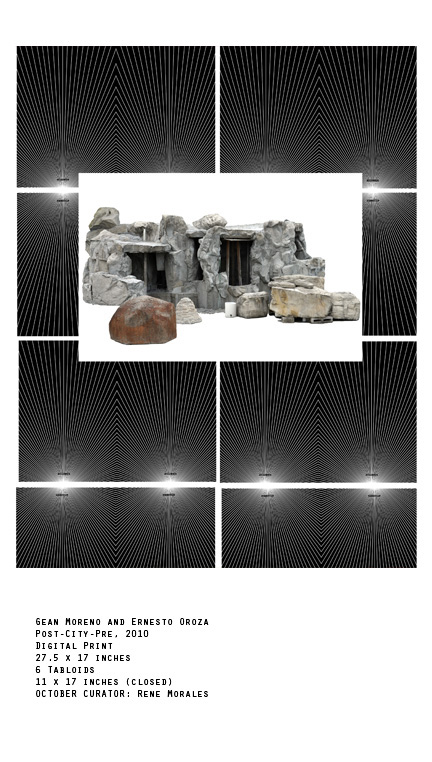
Q: What is the stone structure at the center of the image?
A: The stone structure is an artificial grotto that we found in a landscape nursery. We are using it as a stand-in for what we are calling the pre-city. This pre-city is a kind of abstract plane made up of recurring shapes and materials and colors, filtered through sedimented accumulation of zoning and building codes, that determine what the city will look like. We think it’s there in the repeating vegetation and garden ornaments in plant nurseries, in the prefabricated trusses in the roofing company, in the standard metrics according to which everything is cut in the building materials depot. It’s as if all the different shapes that will make up the city find in these objects their elementary particles. All that we need is to put the individual parts together and we end up with a city like Miami.
Q: The pre-city comes to exist through a filter of regulation, but what about demand and necessity? Could that be as essential as regulation to the accumulation of a city?
A: The city, as a generic structure, happens at the interface between different forces. One of these is represented by regulation, legal precedent, climatological and other adaptations, and the habits of the citizenry. Another force is embodied in the myriad forms and metrics of what we call the pre-city. And yet another is taste/demand. We think of taste not in relation to some endowment to recognize or enjoy the “good things” in life, but as the manifestation of the systematic demands of a particular social group. These different forces are often interdependent, but it is at the points where they meet head-on that the city’s morphologies emerges.
Q: How does it relate to the format of 6 Tabloids?
A: If the pre-city opens a parenthesis, there is a post-city that closes it. Between them, however, there is only an absence where the traditional city once unfolded. We think of places like the salvage yard and the souvenir shop as part of this post-city. It’s not so much where waste goes as were things are deposited which index a change of fashion or building codes, an error in production, or an over-distillation of meaning. These places are almost like large sedimented scabs.
Q: Okay, so you are saying that the junk – souvenirs and waste are junk, just in different ways – becomes an index of expired tastes and needs? That what we either discard as trash or commemorate as kitsch (like snowglobes and miniature Eiffel Towers) could tell an outsider about a city’s consumption patterns? Or do you mean something different than that?
A: Well, within the examples we gave there are certain differences. Although we consider both part of what we are calling a post-city, the salvage yard and the souvenir shop behave in different ways. An important distinction we want to make is between the landfill and the salvage yard–or amorphous junk and the kind of diagrammatic reading that the salvage yard affords us. In the salvage yard one can discern a number of legal, technological, and social changes. A proliferation of doors, for instance, may index a change in building codes. There is also in the way that the salvage yard functions as a commercial entity this process of evacuating cultural value from artifacts, so that they again return to a condition of raw material. One can image the endless rows of pink and pastel blue toilets in the salvage yard morphing into the terrassae that fills in the mosaics in the children’s museum. Garbage, on the other hand, seems to take on its own hard symbolic qualities.
The souvenir shop is different. On the one hand, it participates in the post-city as a kind of trader in dead meanings. It portrays, on the surface, the city not as a lively generative matrix of forces, but as a symbolic construct. It employs widely-shared conventions. Yet, on the other hand, the souvenir, as part of a massive productive system, in the challenges it puts to our safeguarding of stable identity, seems more up-to-date than most objects. It understands generic production. It treats identity as something that is “stamped” on a set of generic artifacts. It invites us to consider a new notion of city-identity, one that is perhaps is more attuned to our global trading networks, our massive communicative infrastructures, and the proliferation of generic production. While it houses obsolete symbols, it seems ahead of most things in its understanding of contemporary production. In this way, it closes the loop: it is both part of the post-city in its tired semiotic inventory, and it is part or emblematic of the pre-city in the understanding of morphologies and processes of the generic.
Q: That’s a fascinating concept, that the souvenir can be a lingering signifier of a city, while it also can be a building block for the inchoate pre-city. Today’s gift shop is tomorrow’s salvage yard. Given your interest in trading, communication, and production at the global level, why do you take on the “the City” as your subject?
A: But there is no difference between the city and the global networks of trading, communication and production. Or another way to say this: cities are just points of compression in these networks.
Living Piggie Lives
September 30th, 2010
The Artist of the Month of September (back to school!) is Berlin-based Dean Sameshima, selected by artist Terence Koh. Dean’s silkscreen print, Untitled (Pig) is a near life-size image of “one fine moment” in his life.
http://www.youtube.com/v/BmF8udrIhVE?fs=1&hl=en_US
Mead Packing
July 30th, 2010
The Artist of the Month of July is Conrad Ventur, selected by Eric Shiner of the Andy Warhol Museum. Conrad is currently featured in Greater New York 2010 at PS1/MoMA, and last spring, Momenta Art exhibited his Screen Tests Revisited. For his AMC print, Conrad produced a snapshot from a live poetry reading by Taylor Mead. Taylor Mead starred in several of Andy Warhol’s films, has been the subject of a documentary, and exhibited his poetry in the 2008 Whitney Biennial: Day for Night.

MB: Who is this old man, what was he reading, and to whom was he reading it?
CV: The man in this photograph is Taylor Mead, the famous Beat Poet and underground film star. Every Monday he does a reading at the Bowery Poetry club. A couple times a month I go see him perform at 6pm. I arrive early and get a cup of coffee and a cookie. I sit next to Taylor at the bar before he goes on, and I share the latest news with him. He’s always got a cocktail in hand.




